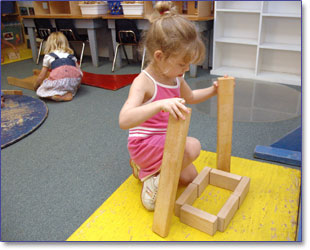  (Page 1 of 3) (Page 1 of 3)
Language is
a complex system that humans use to communicate
with one another. This system includes the ways
we express ourselves, such as speaking or writing,
and ways we receive information, such as listening
and reading. As noted in the introduction, children
come to school with many differences in their
language development. We know that how
much children have to say, how
long
they can sustain active participation in a conversation,
and how many words they know
are indicators of their language ability. We
also know that children’s
language ability upon entering kindergarten
is strongly related to early reading achievement.
Let’s take a look at areas of spoken
language and communication that are important
to early reading achievement.
Meaning and Vocabulary
By listening to and talking with others, children
discover early that spoken language has meaning.
They learn that they can use language to
communicate and make things happen. The more
words they know, the more clearly they can express
their ideas. Children learn the meanings of
many new words from listening to the people
around them. For example, a child may know what
the word happy
means and can figure out that when others say
they are glad that
they really mean they are happy too.
Children may also learn the meanings of new words
through their conversations with others. When
a child finishes a structure in the block area
and tells the teacher, “Look at how big
my building is!” and the teacher responds
by saying “That’s an enormous building!”
then the child learns that the word enormous
is one way to let others know that something is
really big!
 Children
are careful observers of the world around them.
They rely on their observations and interactions
with the world to learn the meanings of new words
or new meanings for familiar
words. For instance, a child who is familiar
with the sandbox in his backyard may be confused
at first when you tell him to put his toy in
the box after he is finished playing with it. Children
are careful observers of the world around them.
They rely on their observations and interactions
with the world to learn the meanings of new words
or new meanings for familiar
words. For instance, a child who is familiar
with the sandbox in his backyard may be confused
at first when you tell him to put his toy in
the box after he is finished playing with it.
Children also learn that changing the forms
of familiar words changes the meaning and use
of these words. For example, when you ask a
child in your class to “sit down,” she
knows to bend her knees and rest her bottom
on a chair. However, when you tell your class
as they are standing in line that they “will
be sitting during the bus ride” they know
you do not mean that they are to sit down immediately—they
understand you are letting them know that
they will be sitting down in the future. Children
quickly and easily learn how to use and combine
words to make things happen. Learning how
to choose both the right words and the right
way to combine those words is important if
children want to express their meaning clearly.
If children are to learn to use language
effectively, they must learn the meanings
of many different words. Children learn to
identify and clarify the meanings of new
words and phrases by carefully observing
experienced language users and thinking about
the objects and actions that are present
during the language exchange. The greater
the variety of language experiences a child
engages in, the greater will be the child’s language
ability.
|